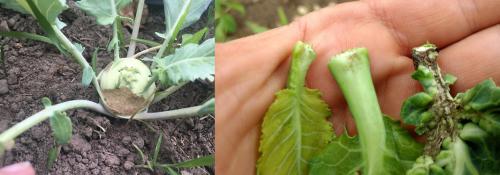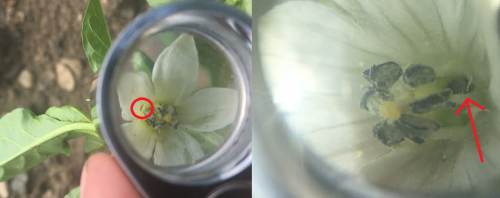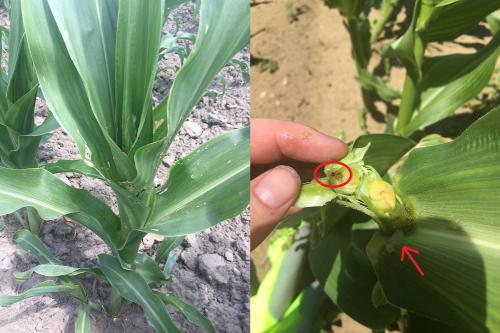Southeast Michigan vegetable update – June 21, 2017
Crops are flowering and fruiting, growers wrapping up planting and beginning harvesting. Things are going smoothly, but have an eye out for pests.

Weather
A more active weather pattern will be moving in over the next few days. While southeast Michigan missed rain that hit most of the state in the last week, there is a chance of rain over the next couples of days. Expect cooler and wetter than average conditions, which may or may not last until the end of the month.
The table below presents rainfall (in inches) for the Michigan State University Enviroweather stations in southeast Michigan with the amount of change from last week reported. Growing degree-days (GDD) starting March 1 are calculated using the Baskerville-Emin Method.
|
Rainfall and GDD totals as of June 21 | |||
|---|---|---|---|
|
Station |
GDD base 50 |
5-year GDD average base 50 |
Rainfall since April 1 (inches) |
|
762 (+134) |
773.2 |
7.07 (+0.45) |
|
|
945 (+156) |
N/A |
8.33 (+0.38) |
|
|
827 (+142) |
887.5 |
7.74 (+0.47) |
|
Crops
Cole crop caterpillars, including diamondback moth, imported cabbage worm and cabbage looper, are all out and sprays are occurring. Early planted cabbage harvest has begun, with good quality generally being reported. Kale is also being harvested.
Growers of all cole crops, especially organic growers with concentrated acreage, should be on the lookout for swede midge, a new invasive pest of brassicas. It has been found in our area, though every life stage of this pest is small and damage can be hard to diagnose. Look for corky brown scarring near leaf petioles, which is easiest to see on kohlrabi.
Other symptoms of this pest include twisted leaves and planting going “blind” and producing multiple heads or stems. These symptoms can be produced by other insects as well as physiological disorders, so feel free to contact me at 517-264-5309 or schuhmar@msu.edu if you see any suspicious plants and I can come check them out.

Left: Swede midge like to feed on tender tissue and, because of kohlrabi’s growth habitat, fed on areas expand to form the saleable portion of the crop, leading to easily visible scarring. Photo by Marissa Schuh, MSU Extension. Right: On these collard plants, scarring ranges from mild to extreme. Close inspection of the middle leaf reveals the larvae of the midge, which are only millimeters long and transparent. Photo by Ben Philips, MSU Extension.
For cucumber growers, MSU Department of Plant, Soil and Microbial Sciences professor Mary Hausback has released updated downy mildew recommendations for the 2017 season.
Peas are being harvested, with volume and quality looking good.
Pepper plantings have enjoyed the warmer weather, but that plants are still short. Some of the earliest plantings are flowering and small fruit are developing. There has been some concern over flower thrips, which are small insects whose adults feed on pollen in the flower and larvae feed on fruit.
There are multiple species of thrips, with western flower thrips causing damage. When dealing with this pest, studies have shown natural enemies are key in control, thus using broad spectrum insecticides that wipe out these natural enemies can lead to an explosion in thrips numbers after spraying.
If possible, use more targeted sprays that are easier on natural enemies early in the season to preserve predator populations. In Florida, where this pest has been a major problem, a threshold of six western flower thrips per flower has been suggested. For more information, see University of Florida’s “Managing Thrips in Pepper and Eggplant.”

Left: Thrips are so small they can only be seen under magnification, making a hand lens a necessity. Right: Minute pirate bugs are the main predators of thrips. They are black and white, oval-shaped insects about 0.125 inch in size. Photos by Marissa Schuh, MSU Extension.
Potato plantings are flowering.
Pumpkin plants are anywhere from recently germinated to knee height with flower buds forming. Squash vine borer adults are out according to Enviroweather’s squash vine borer models, but my traps in Lenawee and Washtenaw counties haven’t captured any adults.
Summer squash harvesting is ongoing, with harvests occurring every other day. Their quality is good.
Sweet corn is at various stages. Some early plantings have green silks, while others have tassels forming in the whorl. If you have either of these situations on your farm, it is time to monitor for various worm pests that feed in the ear.
Corn earworm has been caught in Ohio and Illinois at this point, and it is likely present in Michigan in low numbers. For those interested in trapping for corn earworm, brush up on video tutorials on corn earworm trap assembly and placement.
The first flight of European corn borer has occurred and the resulting larvae are currently feeding on tassels and boring into stalks in our area. MSU Extension field crop entomologist Christina DiFonzo suggests monitoring western bean cutworm regardless if corn is Bt or not, as last year the Cry1F gene failed. Peak flight for this pest is likely to not occur for a couple weeks.

Left: European corn borer whorl feeding gives plants a characteristic shot-hole damage. Right: Larger larvae (circled) migrate into the stalks. The tunnels are signaled by the presence of frass, which looks like applesauce when fresh.
The end of processing tomato planting is in sight. More plantings are flowering and fruit are beginning to develop. The fruit range in size, with the largest being thumb-sized.
Market tomato have begun flowering and fruit are 1-2 inches in diameter.
Muskmelon and watermelon are blooming and fruit are beginning to form. The largest fruit I’ve seen are baseball-sized. Be mindful when using insecticides and fungicides during bloom, as these may hurt the bees necessary for pollination. Spraying late in the day is an easy action to protect pollinators, as bees are busiest mid-morning.
Contact me at any time for pest/disease sampling at 517-264-5309 or schuhmar@msu.edu. I make updates regularly on Twitter at @SoutheastMIVeg.
Meetings
Those interested in the burgeoning local oat market can attend the “Oat Twilight Crop Walk” on June 27 from 6-8:30 p.m. at Zilke Vegetable Farm in Milan, Michigan. For more information and registration, see “Local oats for fresh milling featured at Washtenaw County Field Day.”
The 2017 MSU Weed Tour will be June 28 at the MSU Agronomy Farm. For more information and registration, see “2017 MSU Weed Tour scheduled for June 28.”
Hotels are filling up for the Great Lakes Fruit and Vegetable EXPO, Dec. 5-7 in Grand Rapids, Michigan. The combination of grower-focused, research-backed presentations and an amazing exhibit hall make it a can’t-miss event.



 Print
Print Email
Email




